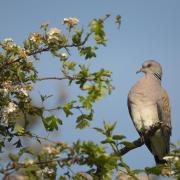In our eighth visit to the centre of our county in International Map Year, we look at the activity and variety of bumblebees found at our chosen site. Words by: Tomas Vujakovic and Peter Vujakovic. Picture by: Manu Palomeque
According to Professor Dave Goulson, founder of the Bumblebee Conservation Trust, more bumblebee species are to be found in Kent than anywhere else in the Britain; 22 of 27 species.
There is, however, a hole in the heart of Kent, with only a single bumblebee species, the ‘common carder’ (Bombus pascuorum), officially recorded there according to Nikki Gammon and Geoff Allen’s excellent book The Bumblebees of Kent (Kent Field Club). But it is nothing to be concerned about. It is simply a lack of information.
Each dot on an animal or plant distribution map simply represents one or more records. A lack of records for the Heart of Kent is not a sign that the bees are not found there, but merely that no one has yet entered an official record for the site. Many distribution maps are as much a record of where surveyors have been active as the actual distribution of the species; this does not mean the maps are not useful, but that they can only provide generalised evidence of where you might expect to find a particular species.
For rare species, they provide evidence of the sort of places where you might look for them. This month’s map, taken from Nikki and Geoff’s book, shows the distribution of B. terrestris, the buff-tailed bumblebee, one of our more common bees. We observed this beautiful bee, despite its absence on the map, on two visits to the heart of Kent in April and June.
Despite the lack of records for the heart of Kent and the fact that the site is beside a cereal field – not a land use that is at all attractive to bees – we observed several species of bumbles during April. The site is backed by a railway embankment, which provides some wild resources for bees and other pollinators.
A major attraction was an early flowering willow tree and some scattered white dead nettles in the field edge. As well as the common carder, we observed the buff-tailed, red-tailed, early, garden and tree bumblebees. In June a wider range of plants was drawing bees to the site, including the green alkanet, bittersweet, hawthorn, and our wonderful dog rose.
In addition to the bumblebees listed above, we also observed two ‘cuckoo’ bumblebees, the vestal and hill cuckoo. Bumblebees, like honey-bees, are social, and cuckoo queens (a social parasite) take advantage of this by ejecting or killing the resident queen and ‘hijacking’ the colony to raise their own young. In evolutionary terms this is a very sensible strategy; putting another species to work for your own benefit!
Bumblebees are only a small group of all the British bees, which number well over 270 species. Many are overlooked, and include small solitary bees, several seen at the heart of Kent, for example the exquisite tawny mining (Andrena fulva).
We have focused on bumblebees, because bees and other insects are attracted to flowers, which make them an easy target for the beginner keen to develop an interest in local wildlife. Find a flower-rich area of chalk downland, pasture, or coastal dunes or simply sit in your garden and these wonderful insects will come to you.
Looking for bees is not only a summer activity; some are now active into the winter where garden flowers allow. This autumn check out any ivy growing on walls or trees; this late flowering plant is a magnet for pollinators, including the ivy bee (Colletes hederae), which was only recorded in the Britain in 2001 and has been spreading into Kent from the coast.
With thanks to ...
Tomas Vujakovic, is President of the FXU Bee Society (Exeter and Falmouth Universities, Penryn). He is currently reading for a degree in Zoology. Kent has been his home since 2007.
Peter Vujakovic, is Professor of Geography at Canterbury Christ Church University. He lectures in biogeography.
w



























